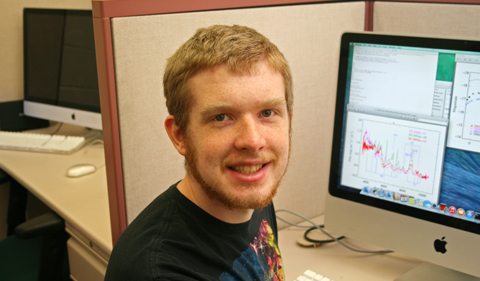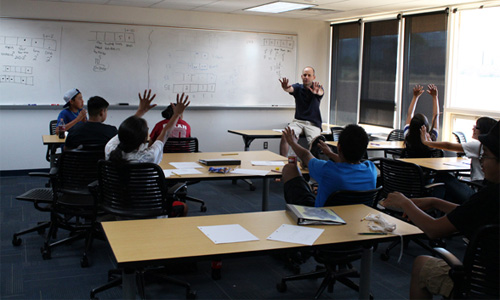
Abdalah El-Barrad
“At the Voinovich School, I gained real world skills that have helped prepare me for industry and academia while creating a positive impact on the world,” says Abdalah El-Barrad, a double-major in Economics and Applied Mathematics.
He was an Undergraduate Research Scholar with the Voinovich School of Leadership and Public Affairs.
The Voinovich School is offering Undergraduate Research Scholar funded positions for the 2017-18 academic year. The application deadline is Feb. 12. Interested students should email a cover letter, resume, recent DARS report and short writing sample to: Dr. Ani Ruhil, Associate Professor, 740-597-1949, ruhil@ohio.edu.
Mapping Racial and Ethnic Minority Population Density in Ohio
In December 2015, El-Barrad and senior journalism student Danielle Keeton-Olsen showcased their work at Voinovich.
Keeton-Olsen and El-Barrad worked to create a map of racial and ethnic minority population density in Ohio. The project demonstrates differences in minority population density through a color-coded scale, with dark blue representing the highest levels of minority population density and light blue/gray representing the lowest levels of minority population density. The map allows users to analyze differences in population demographics at both a large scale, comparing differences across Ohio counties, and a small scale, examining block-by-block demographics in individual counties.
Keeton-Olsen and El-Barrad demonstrated these uses of the map to the audience, drawing attention to the larger minority populations in Ohio’s urban counties contrasted with the smaller minority populations in rural counties. The presenters then focused in on Athens County, exploring differences in the demographics of distinct areas.
“This is really cool for me as a journalism major because there aren’t very many people who dig into data journalism from this deep of a level,” Keeton-Olsen said. “There are so many hidden stories that are available and accessible online through census data. You can really dig down into the population in your community, which would be very interesting if I wanted to pursue investigative journalism or something along those lines. And then I can also make my research into a very pretty map and present it online.”
El-Barrad said he appreciated gaining the skills necessary to compile data into visual aids like the map on which he and Keeton-Olsen were presenting. “The hardest part was understanding the data and getting the data,” he said.
Although the map — which is intended to be published — could have a variety of uses, it was developed specifically to assist the Ohio Department of Mental Health and Addiction Services as the department strives to provide targeted minority populations, particularly in rural areas.
Taking Second in Scripps Innovation Challenge
Campaign finance data is publicly available, but not everyone is an expert data analyst — and, if you’re looking to gain meaningful information, there’s quite a lot of data to slog through. That’s what inspired senior journalism student Keeton-Olsen and El-Barrad, a junior dual majoring in applied mathematics and economics, to work with three other undergraduates to create an algorithm called ConnectWatch, which analyzes accessible databases to monitor how money influences elected officials and reveal questionable connections.
“This data exists, but no one’s really digging into it or unlocking the potential that it holds,” Keeton-Olsen said.
Keeton-Olsen and El-Barrad worked together as Undergraduate Research Scholars at the Voinovich School. Through their work, Keeton-Olsen became familiar with El-Barrad’s skills and decided early in the course of the project to invite El-Barrad to join her team.
“We were looking for someone who could work on mechanizing the project and making the process faster,” Keeton-Olsen said. “Abdalah is a lot better at the programming side than I am, and I’m better at thinking about the stories that the data can tell, because that’s what I’m trained to do.”
Accordingly, over the course of the project, Keeton-Olsen worked primarily on the journalism and communications side while Abdalah wrote scripts to map questionable connections and worked on data crunching.
“The more I learned about it, the more into I got,” El-Barrad said. “It quickly became a cool project for me.”
The group of five students entered their idea in the fourth annual Scripps Innovation Challenge, a University-wide student competition to create innovative solutions to real-world media and communication problems. The competition was open to all Ohio University students, regardless of major. Winners were selected after presenting their ideas on Pitch Day to a group of media industry professionals.
The team, named “The Honey Badgers,” also included Logan Leland, a junior majoring in computer science, and journalism seniors Will Drabold and Sam Howard. In the end, the group won second place and took home $5,000.
Keeton-Olsen attributed the group’s success to the contemporary need for a project that makes campaign finance data easier to work with and understand.
“Everyone can use data like this, but they don’t know they can use it,” Keeton-Olsen said. “That’s why there’s so much potential behind this. I think immediately of the data journalism potential.”
The pair was honored to have their work recognized by taking second-place at the competition — and they were also excited about the corresponding renown and the cash prize.
“The day after we won, I put it on my LinkedIn, because I was really excited,” El-Barrad said.
The group is unsure exactly what they will do to advance their work from here. However, they have been approached by several professors who are willing to help them carry out their vision.
Although the goal of the Scripps Innovation Challenge is for students to develop new and innovative products, tools, or strategies that could be the basis for a startup business or a new entrepreneurial venture by an established company, if the project is ever finished, El-Barrad said it would likely be open-access.
“We’re doing a research project, and it’s mostly for the sake of learning,” El-Barrad said. “The way it seems, I don’t think the end result will be entrepreneurially geared. If we finish it, it will probably just be free use.”
Keeton-Olsen echoed this sentiment.
“This was a cool, interesting, insightful project for me, but if I were to participate in the future, I’d rather be working in the newsroom rather than starting up a business,” she said.
Both Keeton-Olsen and El-Barrad said that their work at the Voinovich School helped to make this project possible.
“Everything we learned at the Voinovich School about data helped us a lot,” El-Barrad said. “I wouldn’t have ever learned much about working with data, if it weren’t for my time at the Voinovich School.”
Anirudh Ruhil, an associate professor at the Voinovich School and Danielle and Abdalah’s supervisor, said he is regularly inspired by the pair.
“Both Abdalah and Danielle have been fantastic students to work with, and I consider myself lucky to have had this opportunity,” Ruhil said. “Abdalah is a stand-up comic with a computer programmer’s brain, and Danielle is one of the keenest minds I have seen in a long time. Both of them were immensely helpful in cleaning, analyzing and visualizing data. They also rendered some beautiful and effective interactive data visualizations.”
Ruhil enjoyed seeing the pair take their skills in data analysis beyond the context of the Voinovich School and into their own work.
“What is most impressive here is that they have done this on their own, A to Z,” Ruhil said. “The Scripps win is a testimony to their innovativeness underwritten by strong analytical minds.”


















Comments